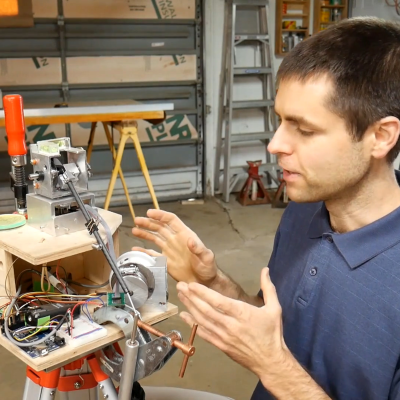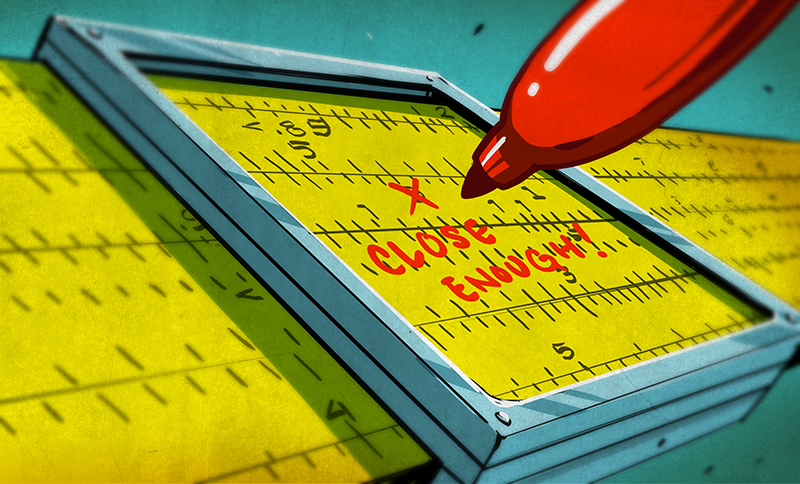If you’ve taken a physics class, you’ve doubtless heard tales of mythical beasts like the massless string, the frictionless bearing, and the perfect sphere. And if you’re designing something new, it’s not always wrong to start by thinking in terms of these abstractions, just to get the basic framework laid and a first-order handle on the way things go. But once you start building, you’d better be ready to shed your illusions that a 6 mm peg will fit into a 6 mm hole.
 Theory and practice are the same thing, in theory. But as soon as you step into practice, your “weekend build” can easily turn into a 500-hour project, full of hurdles, discoveries, experimentation, and eventual success. I’m not going to rehash [Scott Rumschlag]’s project here — you should really watch his detailed video — but suffice it to say that when building a sub-millimeter precision 3D measuring device, bearings do have friction and string does have non-zero mass, and it all matters.
Theory and practice are the same thing, in theory. But as soon as you step into practice, your “weekend build” can easily turn into a 500-hour project, full of hurdles, discoveries, experimentation, and eventual success. I’m not going to rehash [Scott Rumschlag]’s project here — you should really watch his detailed video — but suffice it to say that when building a sub-millimeter precision 3D measuring device, bearings do have friction and string does have non-zero mass, and it all matters.
When you start working on a project that “looked good on paper” or for whatever reason just doesn’t turn out as precisely as you’d wished, you could do worse than to follow [Scott’s] example: start off by quantifying your goals, and then identify where every error along the way accumulates to keep you from reaching them. Doing precise work isn’t easy, but it’s not impossible either if you know where all the errors are coming from. You at least have a chain of improvements that you can consider, and if you’ve set realistic goals, you also know when to stop, which is almost as important.
And if anyone out there has an infinite sheet of perfectly conductive material, I’m in the market.
















https://hackaday.com/2021/07/01/sub-mm-mechanical-3d-scanner-with-encoders-and-string/ ???
It was linked in the article as “turn into a 500-hour project”.
“And if anyone out there has an infinite sheet of perfectly conductive material, I’m in the market.”
I have one I would sell you but it’s currently stuck under my immovable object. If you have an unstoppable force then you just might be able to get to it.
Could always tow that immovable object away with the world’s strongest and cheapest chain.
I’m still looking for spherical cows.
On the other hand, 1/3 of the body shape of the general population is approaching spherical…
Hey, I resemble that remark!
+1 for shakespearean reference
Our school said they wanted the pupils not just to excel academically, but be well-rounded.
I hoped they don’t end up as rounded as the headmistress.
Haha. My old headmaster had some of that going on.
Mens sana in corpore flabo
Ah, there’s your problem. It is spherical chickens, and homogeneous isotropic cylindrical cows that make physics work. And just when you get the hang of it along comes vector calculus with Div, Grad, and Curl, and for some reason everything looks like an old potato.
https://www.youtube.com/watch?v=6HJYRbG9u8Y&t=121s
Also watch: “rollin’ Safari”.
If you want to really see how this sort of drilling-down to find all the sources of error is done, have a look though the publications from the metrology folks at NIST. Or just follow the timenuts mailing list for an abbreviated version.
It takes a special kind of mind to go to those extremes in search of perfection.
Not so unusual. Common stuff for any company that needs to get accredited. Measurement Uncertainty worksheets are required for each type of measurement, for a particular instrument at a particular setting, and for a particular lab location, and for a named person. The first time you do it is a bit over whelming. It becomes easier for subsequent audits and submittals. Treat rms and peak errors as systemic single-point absolutes so you do not have to do error propagation stuff.
And my mind is not so special – it is actually full of mundane and pedestrian thoughts.
See GUM for the canonical reference.
NIST does some amazing work, for sure. Their budget also differs significantly from mine…
But not just there — the whole hubbub about the muon g-2 experiment is basically just arguing about the 23rd decimal place. https://hackaday.com/2021/05/11/the-mysterious-wobble-of-muons/
Precision is one of those things that you really need it when you really need it.
Differences are science vs engineering. Pure sciences worry about knowledge and don’t necessarily have an end product. Engineering is dealing with real life limitations and often economics. e.g. availability of parts, unideal parts/material, production yields, cost etc.
So are you calling this story of device creation Science, or Engineering?
He didn’t pull together a bunch of engineering principles, sit down to design a device to those rules, source parts and build it. He didn’t do that sort of procedural engineering. He did a serious R&D effort — lots of blind alleys, experimentation and measurements. Lots of measurements. Definitely moving the needle over to the “Science” side.
It’s that pursuit of “why?” and “how?” that makes it Science. Pushing beyond the safe envelope defined by engineering is where discoveries are found.
If it uses stuff other than calculations and assumptions, then it is Engineering. Even as you said “pushing beyong the safe envelope” is still engineering.
Science is purely theory, now going into practice (even top notch experimentation) is already in the realms of engineering
Most science isn’t theory. Theory is just the first step.
without engineering science is just philosophy.
Very instructive article, a goldmine of informatioms !
Oh cruel reality, why does it always have to contradict my beautiful theories!
did anyone else cringe a bit at the thought of using a sharpie to mark up a slide rule?
Is anyone out there who hasn’t learned that anything you start to build, you need to multiply the time 3x-5x you expected? :D
In college, around Thanksgiving time, inevitably some professor would assign a problem which started as “assume a spherical turkey”!
There was a story where I worked where a Senior Engineer tasked the co-op student (like an intern) to buy ideal op-amps from Digikey. This poor kid was on the phone for like an hour with the nice saleslady from trying to figure it out…
“your “weekend build” can easily turn into a 500-hour project, full of hurdles, discoveries, experimentation, and eventual success”
Oh, it’s that last part what i’ve been missing. Where can i get one of those? I’ve been looking everywhere.